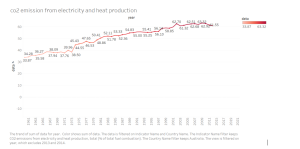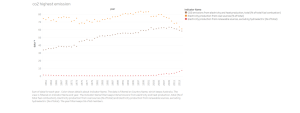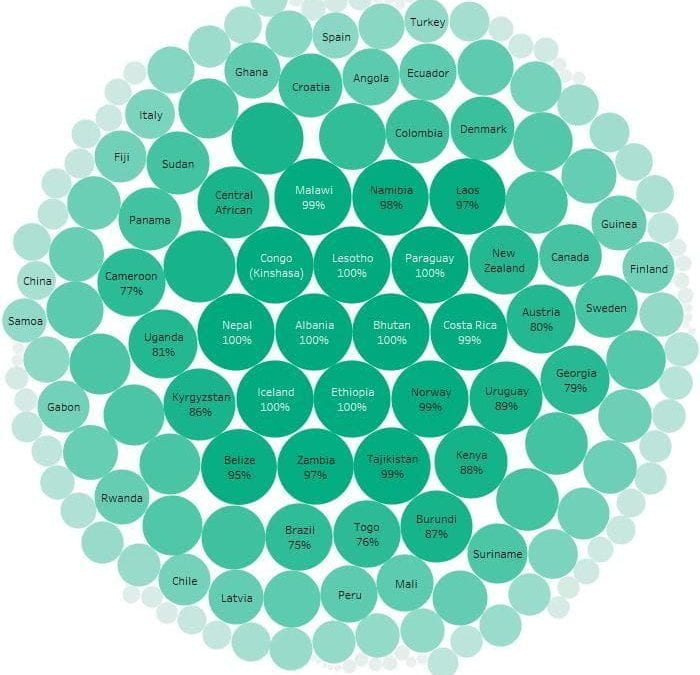
by aaa237 | Nov 22, 2022 | Uncategorized
THE 17 GOALS: Affordable and clean energy in australia:
CO2 emissions is one of the hottest topics nowadays especially in Australia where they are suffering from the high emission of CO2. CO2 leads to many problems in the atmosphere warms the planet, causing climate change.
In the last 30 years the emission of CO2 in Australia has been increasing significantly, that line chart here shows the trend of consecutive increase over the years.

Energy-related CO2 emissions is increasing by years This is abundantly seen when we examine emissions from energy generation in Australia. We can see here that the CO2 emission increase significantly as more electricity is generated where more than 30% increase in the CO2 emission generated from the electricity production.

The coal in Australia plays an important role in it economy and that what made Australia so rich, the high availability of that natural resource.
It’s well known that the coal is used worldwide for electricity production, as Australia is one the richest country in coal resources them energy-related carbon emissions from coal resources have risen to arrive to a maximum of 84% which was primarily due to rising energy consumption in Australia.
The CO2 emission from electricity and heat production followed an incremental trend until 2001 where it started to fluctuate that is caused as we can see to the decrease in the electricity production from coal sources here a new line shows up that stated to going upward but at very shy way that is the electricity production from renewable sources.

the renewable energy consumption in Australia is 10.13% of total final energy consumption at the end of 2019 which is considered very low considering Australia as a developed country only a small portion of that 10.13 is used to produce electricity as we can see in 2014 9.32% is the renewable energy consumption of total final energy consumption only 7.5% of that is used to produce electricity.

So, what are the barriers for Australia for not up taking renewable energy?
Information
Some consumers and companies may be unaware that installing solar panels might help them save money and hence fail to analyze the potential. They may also lack a reliable installation and are unsure how to locate an appropriate provider.
The cost of capital
For many individuals, the initial capital expenditure of solar panels is a substantial barrier to realizing the financial benefits of free power.
Priorities
People may be aware that installing solar panels is a good idea, but they may have other priorities that must be addressed first.

by Tamar Gebrael | Nov 25, 2021 | Dashboard, Visualization
How many hours do you have access to electricity? At what time are the generators turned off in your region? How much was your electricity bill last month?
These questions might sound unfamiliar for citizens in many countries. However, they became part of any discussion in Lebanon reflecting the limited access to power for the majority of the population.
Which areas suffer from this same problem?
Most of the countries having energy shortage are located in Sub-Saharan Africa. For example, in South Sudan, Burundi and Chad, less than 10% of the entire population have access to electricity

Comparing the distribution of the average access to electricity between rural and urban areas, it can be observed that urban areas have more power access. Subsequently, countries having energy deficiency should consider using international funds for the installation of power distribution systems in rural areas.
What about Lebanon?
Although this country has a very remarkable amount of water resources, its hydraulic energy production is insignificant compared to its thermal energy production. Correspondingly, decisions should be taken to make use of our rich water assets.
The map shown below represents the distribution of the power stations in Lebanon.

Source: https://www.sciencedirect.com/science/article/abs/pii/S1364032112006259
Lebanon doesn’t have enough power stations which affects the power distribution among the areas and causes loss of energy in the transmission lines. Accordingly, the government should consider creating more thermal and hydraulic energy auxiliary stations to secure an even electricity distribution among all areas.
To increase electricity access, it’s recommended that the governments of developing countries take action by using wisely the international funds for the installation of power generation plants and transmission networks to cover all population needs (in all areas), taking into consideration economical and social conditions. Transparency in government should be followed by spreading public awareness to find and support policies that manage assets like coal, oil and gas as a source of energy and income. Moreover, the use of renewable sources including hydroelectric energy is an important step to generate electricity in both rural and urban areas.
Resources:
World bank data : https://datacatalog.worldbank.org/home
Open data Lebanon: https://www.opendatalebanon.org/

by Mario Khalil | May 3, 2020 | Visualization
The World is investing heavily in clean energy. Some countries now produce their entire electricity output from renewable sources. A lot of these countries are in Africa, could it be their next century?
The data source is from the International Energy Agency where they compare the usage of clean energy out of their total consumption.








